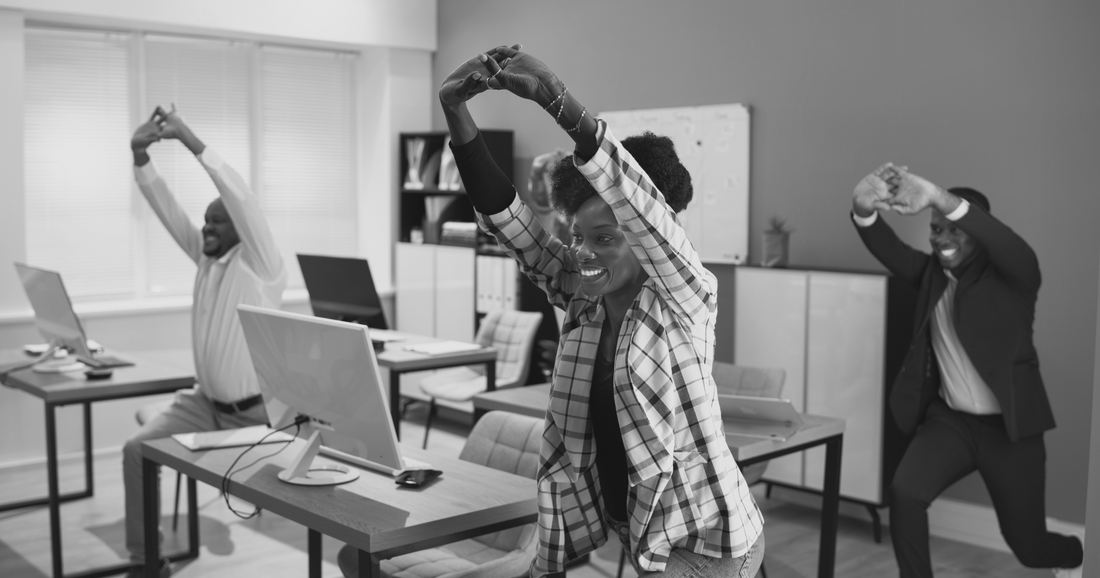
Desk Fitness: 10 Simple Workouts You Can Do at Your Desk
Share
Sitting for long hours at your desk can leave you feeling stiff, tired, and sluggish. Whether you work from home or in an office, staying active during the day is important for your health. But what if you don’t have time to hit the gym? That’s where desk fitness comes in.
Desk workouts are short, simple exercises you can do right at your desk, no equipment or gym clothes needed. They help you stretch, strengthen your muscles, and boost your energy during the workday.
In this post, we’ll share 10 simple desk workouts to keep you active, reduce stress, and feel better while working.
Why Desk Fitness Matters
Most people sit for 6 to 8 hours a day. Long periods of sitting can lead to:
- Poor posture
- Back, neck, and shoulder pain
- Tight hips and legs
- Low energy and focus
- Increased risk of weight gain and health issues
Desk fitness helps fight these problems by encouraging movement throughout the day. Even a few minutes of stretching or light exercise can improve blood flow, wake up your muscles, and clear your mind.
Let’s get into the workouts.
1. Seated Leg Lifts
This move strengthens your quads and engages your core. It’s a great way to wake up your lower body while staying seated.
How to do it:
- Sit up straight with your feet flat on the floor.
- Extend one leg straight in front of you and hold for 5 seconds.
- Lower it slowly and repeat with the other leg.
- Do 10 reps on each side.
You can add ankle weights for more resistance, but it works great with just your body weight too.
2. Desk Push-Ups
Want to work your arms and chest? Desk push-ups are a perfect way to build upper body strength without getting on the floor.
How to do it:
- Stand a few feet away from your desk.
- Place your hands shoulder-width apart on the edge.
- Keep your body straight and lower your chest toward the desk.
- Push back up to the starting position.
- Do 10–15 reps.
Make sure your desk is sturdy enough to support your weight before starting.
3. Seated Torso Twists
Torso twists help loosen up your spine and stretch your sides. They’re perfect for breaking up hours of sitting.
How to do it:
- Sit tall in your chair with your feet flat on the ground.
- Place your right hand on the back of your chair.
- Twist your upper body to the right while keeping your hips facing forward.
- Hold for 10 seconds, then switch sides.
- Repeat 3 times per side.
This move also helps improve posture and reduce lower back tension.
4. Calf Raises
Calf raises are a simple way to get your blood flowing and strengthen your lower legs, especially if you’ve been sitting for a while.
How to do it:
- Stand behind your chair and hold the back for support.
- Raise your heels off the floor, standing on your toes.
- Hold for 3 seconds, then lower back down.
- Repeat for 15–20 reps.
You can also do these while brushing your teeth or waiting for coffee to brew.
5. Shoulder Rolls
This quick stretch helps relieve tension in your neck and shoulders, which are common areas of tightness for desk workers.
How to do it:
- Sit or stand with your back straight.
- Roll your shoulders forward in a circular motion 10 times.
- Then roll them backward 10 times.
- Take deep breaths as you move.
Do this every hour to prevent stiffness from building up.
6. Desk Squats
Squats are great for your glutes, thighs, and core. Doing them at your desk helps wake up your lower body and get your heart rate up.
How to do it:
- Stand in front of your chair, feet shoulder-width apart.
- Lower yourself as if you’re going to sit, but stop just above the chair.
- Push through your heels to stand back up.
- Do 10–15 reps.
Make sure to keep your chest up and knees behind your toes.
7. Seated Marching
This is a fun and easy way to keep your legs moving and improve circulation.
How to do it:
- Sit tall with your feet flat on the floor.
- Lift one knee toward your chest, then lower it.
- Alternate legs like you’re marching in place.
- Do 20–30 reps, or march for 1 minute.
You can even do this while on a video call or reading emails.
8. Neck Stretches
Neck pain is one of the most common complaints for people who work at desks. These gentle stretches can help reduce pain and improve range of motion.
How to do it:
- Sit up straight and slowly tilt your head to one side.
- Hold for 10–15 seconds, then switch sides.
- You can also gently look left and right, holding each side for a few seconds.
- Repeat 3–4 times in each direction.
Do this anytime you feel tension or tightness in your neck.
9. Wrist and Finger Stretches
Typing and using a mouse all day can strain your hands and wrists. Stretching them regularly helps prevent carpal tunnel and hand fatigue.
How to do it:
- Extend one arm forward with your palm facing down.
- Use the other hand to gently pull back on your fingers.
- Hold for 10 seconds, then switch hands.
- Repeat with palms facing up.
Stretch your wrists and fingers every couple of hours, especially during long typing sessions.
10. Standing Side Bends
Side bends stretch your core and help improve flexibility. They also give your back and hips a nice break from sitting.
How to do it:
- Stand with your feet hip-width apart.
- Reach your right arm overhead and lean to the left.
- Hold for 10 seconds, then switch sides.
- Repeat 3–5 times per side.
Breathe deeply as you stretch to relax your body and release tension.
When you're fitting in quick movements between meetings, the gear you wear matters too. Built By Battle’s wellness clothing for active workdays is made to move with you, offering comfort and motivation throughout your day. Our motivational apparel for workplace movement helps you stay focused, energized, and confident even when your space is tight.
How to Fit Desk Workouts Into Your Day
Even though these moves are quick, it helps to build a routine around them. Try these tips to stay active throughout your workday:
- Set a timer every hour to remind yourself to move.
- Pick 2 or 3 exercises and do them between tasks or meetings.
- Stretch after lunch to help avoid the afternoon slump.
- Create a mini workout break with 5 or more exercises during longer workdays.
These mini workouts help refresh your brain and prevent fatigue. Movement increases blood flow, which helps your body and mind stay alert.
Bonus Tips for Staying Active at Work
Beyond desk workouts, there are other small ways to add movement to your day:
- Take the stairs instead of the elevator.
- Stand while talking on the phone.
- Walk during meetings or brainstorm sessions.
- Use a standing desk if it’s available.
- Stretch during loading screens or break times.
Staying active doesn’t have to mean hitting the gym or going for a long run. Little movements throughout the day can add up to big health benefits over time.
The Benefits of Desk Fitness
Doing simple desk workouts has more benefits than just reducing stiffness. Here’s what you gain by moving throughout the day:
- More energy and focus
- Improved posture and less pain
- Better circulation and heart health
- Reduced stress and anxiety
- Increased productivity and mood
When your body feels better, your mind works better. Desk fitness is a smart, simple way to boost your health and your work performance.
Final Thoughts
You don’t need fancy equipment or lots of time to stay fit during the workday. These 10 simple desk workouts can help you stay active, reduce pain, and keep your energy levels up, without ever leaving your workspace.
Start by adding one or two moves to your daily routine. Set reminders, take short movement breaks, and listen to your body. The more consistent you are, the better you’ll feel.
Remember, staying healthy at work doesn’t require big changes. It just takes a few minutes of movement, and a little commitment to yourself.
